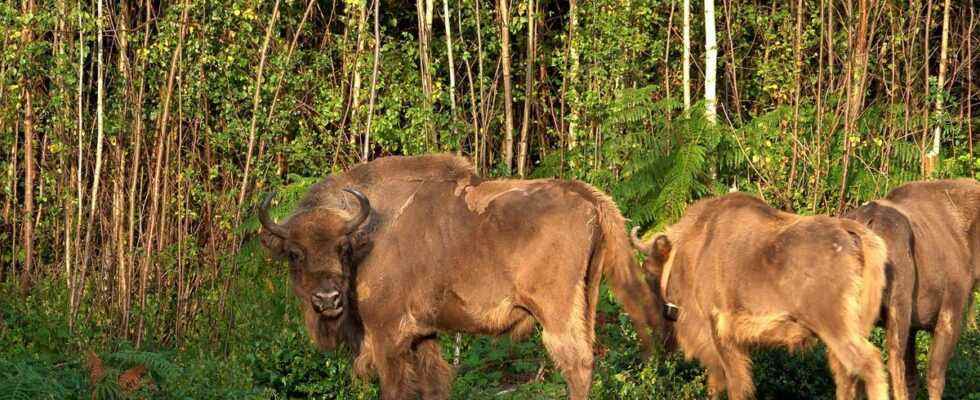Under a rising sun over south-east England on Monday July 18, three bison leave a paddock for a wood, their new home as part of an ambitious reintroduction project.
The trio immediately start chewing leaves from trees in this forest near the city of Canterbury.
An important event”
It is the first time in millennia that the European bison, the largest land mammal on the continent and closest cousin to the steppe bison that once roamed Britain, will once again roam free. An event “really important», underlines Mark Habben, of the Wildwood Trust, at the origin of this project.
“Couldn’t have gone better, they turned around, looked at us and disappeared into the forest“, he describes a few moments after the reintroduction. The female bison, a matriarch, accompanied by two younger females, will now graze, eat bark, chop down trees and revel in dust baths, turning up the soil in the woods.
55 to 200 hectares of wood
Their presence will bring about multiple benefits, helping other species to create their habitats, while bison makeecosystem engineers“. “We do this to restore the environment and restore the English Forest and all that thrives there», explains Mark Habben. “We don’t want to use machines…using indigenous resources from ecosystem engineers as we like to call them – in the form in this case of the European bison – is exactly the right thing to do.»
Read alsoA man injured by a bison in Yellowstone Park in the United States
SEE ALSO – United States: a 9-year-old girl is charged by a bison
The female bison, who has lived in paddocks in Ireland and the Scottish Highlands, will be joined by a bull in the coming months. The arrival of the male from Germany was delayed by post-Brexit formalities for importing animals. The herd will initially benefit from 55 hectares of demarcated woods, before their space is increased to 200 hectares.
The hope is that the arrival of the bull bison will increase the size of the herd, with the site able to accommodate up to 20 boarders. The bison will soon be joined by ancient breeds of ponies, pigs or cows. “This is a model for what we hope to roll out more widely in the UK», continues Mark Habben.
1.3 million euros
The last of the European bison died out on the continent in 1927, a victim of hunting and habitat loss. Fifty individuals have been kept in captivity, serving as the basis for a breeding program, according to project officials. The trio that has just taken up residence in Kent is descended from their lineage.
One of the other aims of the scheme – the cost of which is £1.1m (€1.3m) mostly funded by private donations – is to help UK ecosystems in the face of climate change and the decline of biodiversity. The reintroduction coincides with an episode of heat which promises to be unprecedented in the United Kingdom, where temperature records are likely to be exceeded.
Read alsoThe great return of the Atlantic sturgeon, a fish that can live 140 years and weigh the weight of a bison
Circumstances which according to Habben highlight the relevance of the project. “It’s an amazing story really, that we’re reintroducing bison to help restore ecosystems», for in the end, «hopefully have an impact on climate change“.
